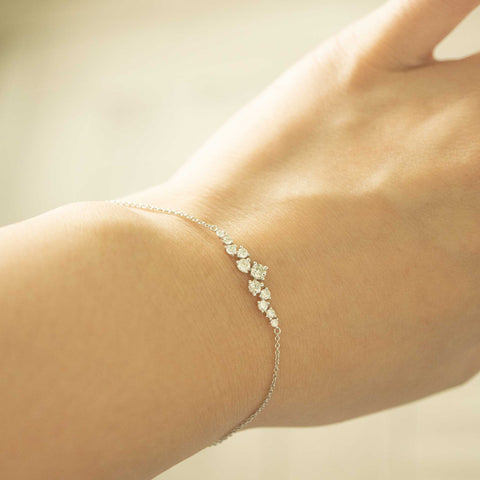As you know, we recently launched a mini collection with moissanite gemstones set in solid gold. Both diamonds and moissanite may have a lot in common, but there are several key differences that makes them unique.

(The Cluster Moissanite Bracelet with D-coloured, VVS moissanite gemstones set in 14K Solid White Gold)
Diamonds have always been the traditional go-to gemstones for engagement jewellery. But in recent years, there's been a rise in alternative gemstones such as moissanite, or if you fancy, coloured gemstones such as emeralds, topazes and sapphires.
What are they?
Known as gem from the stars, moissanite ("moy-suh-nite"), were first founded by French scientist Henri Moissan in 1893. His first sample of moissanite (named after him) was found on the inside of a meteorite crater. Today, natural moissanite are extremely rare and since the 1990s, gem scientists have perfected the creation of these gemstones in a lab, making it a sustainable option for conscious collectors.
Moissanite is created with silicon and carbon, through a combination of pressure and heat. What makes them different from diamonds (made from carbon) is its chemical make up and specific features when viewed in person.
How do they compare against diamonds?

In the last few years, it has become one of the top diamond alternatives (especially when it comes to engagement jewellery) for its durability, brilliance and of course, affordability. For a single carat, a moissanite can be a third of a diamond's price. This naturally makes it a great alternative for those who are looking for an environmentally friendly gemstone that's friendlier on the without compromising on the sparkle.
The most notable difference between moissanite and diamonds is the price. This can be attributed by several reasons,
- A naturally higher supply and demand for diamonds
- Diamonds are mostly natural rather than lab created (with the exceptions of lab created diamonds), this can vary hugely in price, value and quality.
- A diamond's price varies depending on its cut, clarity, carat and colour
Let's have a look at some of the key differences between moissanite and diamonds below:

How do you tell the difference between moissanite and diamonds?
These are several ways with the help of professional equipment. Diamond testers that measure electrical conductivity can tell you if a stone is a diamond or not, but not necessarily what the stone is. There are moissanite testers as well.
But if you're just armed with the naked eye, you can tell the difference with a similar sized moissanite and diamond by placing it side by side. Diamonds have a distinct way of reflecting light and give off a white-ish sparkle. Moissanite on the other hand, give off a rainbow like sparkle (similar to that of a disco ball) when the gemstone is moved around. This is more pronounced under sunlight.
Either way, both moissanite and diamonds are beautiful gemstones in their own right - we can't do without either. For us, we appreciate the beauty and durability of a moissanite, making it one of the few gemstones that's well suited to fine jewellery.
Till next time.
X,
D

